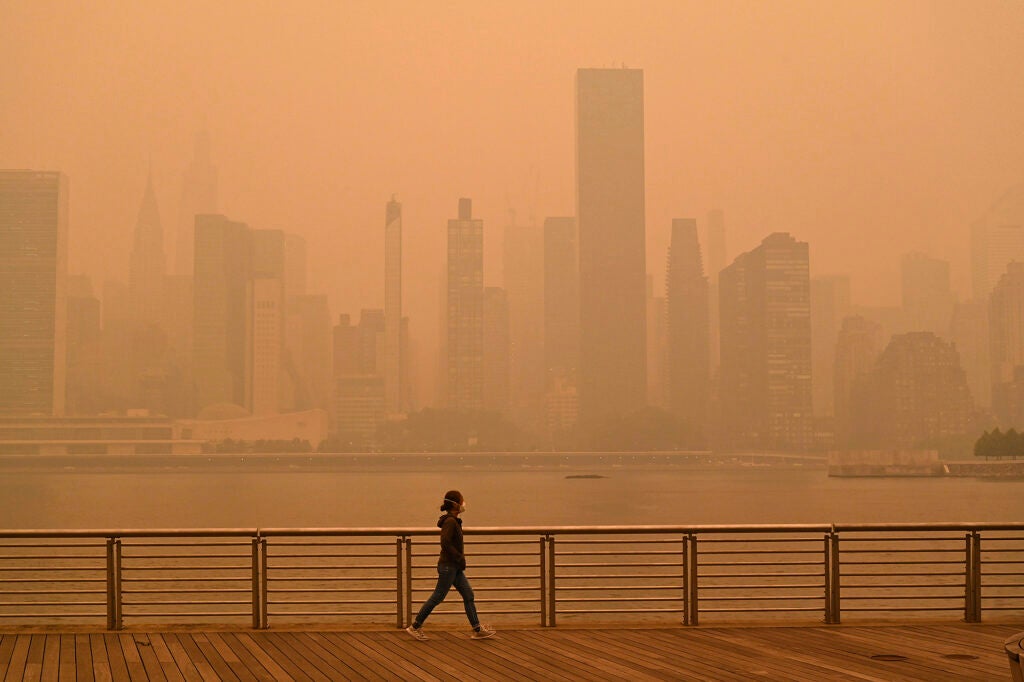Summer Is Overheating. Here’s What We’re Doing About It.
Burning fossil fuels is making summer more prone to extreme weather events. Here’s how we’re tackling the climate crisis.

This page was published a year ago. Find the latest on Earthjustice’s work.
The extreme impacts of climate change are reshaping our summers – and this one is on track to be among the most brutal yet in the U.S.
Residents of the Gulf Coast are just beginning to repair the damage from Hurricane Beryl, the earliest category 5 hurricane on record, fueled by exceptionally warm ocean waters. One recent heatwave had more than 245 million Americans enduring 90-degree temperatures. In several states, weather has gotten so chaotic that insurers are dropping homeowners’ coverage, and nationwide, transportation infrastructure not built for these conditions is under strain.
We know the primary cause of this extreme weather: the extraction and burning of fossil fuels, which have disrupted the earth’s climate with heat-trapping emissions. And we have the legal tools and solutions to change course.
Earthjustice is fighting at every level to accelerate the transition to clean, renewable energy and end dependence on fossil fuels. This includes fighting the industry’s aggressive plans to lock in yet more oil and gas infrastructure, and working to replace outdated, polluting gas plants with clean energy.

A photo of Hurricane Ian in the Caribbean Sea, taken on September 26, 2022 from the International Space Station. (NASA)
How Extreme Weather Causes Harm
Every extreme weather disaster creates ripple effects that affect communities, jobs, public health, and the environment. Here are just a few:
Chemical Disasters
On the Gulf Coast, which houses roughly half of the country’s oil and gas refineries, the danger hurricanes bring is magnified by the release of toxic chemicals in people’s air and water, when high winds and flooding damage oil, gas, and chemical facilities.
Deadly Heat
Summer heat waves are creating a deadly situation for outdoor workers, who often must choose between risking the agony of heat stroke and losing their pay. “I feel like I’m drowning,” says Griselda Lomeli, a worker at a plant nursery in southern Florida who has experienced heat stress. “I’m suffocating. My heart beats very quickly, and I can hear it accelerating.”
In just one week this summer, more than 50 cities in California and Nevada broke heat records. Las Vegas topped out at 120 degrees, its hottest temperature ever recorded.
Toxic Air
Wildfires create smoke that is even more dangerous for our health than other types of air pollution. The soot in wildfire smoke (also called particulate matter, or “PM2.5”) can penetrate deep into our lungs and is linked to increases in heart attacks, strokes, and lung cancer, as well as hampering lung growth in children. As climate change fuels hotter and drier conditions, wildfires now account for nearly 40% of the U.S.’s particulate matter pollution.

People walk along Park Avenue and Grand Central Terminal as they are covered in a haze from Canada wildfires on June 7, 2023 in New York City. (NDZ/STAR MAX/IPx via AP)
Addressing the Causes of Extreme Weather
The news may seem dire, but hopelessness is not an option for our only planet and the millions of species who live on it. Earthjustice is rising to meet the realities of climate change. Here are just a few ways we’re combating extreme weather impacts and creating pathways to a clean energy future:
Cleaning Up Polluting Power Plants
After years of advocacy from Earthjustice and community groups, the U.S. Environmental Protection Agency (EPA) has finalized the first-ever standards to limit carbon pollution from new gas and existing coal-burning power plants. Until now, these plants have had a free pass to dump climate-warming emissions into the air.

A bird flies by the emissions from the coal-fired Gavin Power Plant in Cheshire, Ohio. (Stephanie Keith / Getty Images)
Ending Fossil Fuels’ Grip on Our Power Grid
You’ve probably never heard the names of the people on your state’s public utility commission, but these under-the-radar regulators have enormous power to transform the nation’s power grid and alleviate the climate crisis.
We’re advocating at public utility commissions to stop utilities from forcing consumers to bail out unprofitable coal or pay for new fossil gas we don’t need, and instead secure utility investment in renewable power, energy efficiency, and other clean energy alternatives.
Making Polluters Accountable for Soot Pollution
Wildfires aren’t the only source of toxic soot — it also comes from fossil fuel combustion for electricity generation, manufacturing, transportation, and agriculture.
Earthjustice successfully pushed the Environmental Protection Agency (EPA) to finalize new, tighter standards on PM2.5 air pollution, saving thousands of lives. We’re also intervening to defend the EPA’s new standards in court against a challenge by industrial associations, including the American Petroleum Institute.

Broken power lines, destroyed by Hurricane Ida, are seen along a highway as flares come out of a petroleum refinery on August 30, 2021 outside LaPlace, Louisiana. Ida’s eastern wall went right over LaPlace inflicting heavy damage on the area. (Michael Robinson Chavez / The Washington Post via Getty Images)
Protecting Communities from Toxic Releases During Storms
Earthjustice helped push the federal government to adopt new storm-preparedness safeguards aimed at nearly 12,000 chemical plants. These crucial measures are designed to mitigate risks of explosions, fires, and other hazardous industrial incidents, which are a constant danger for coastal communities experiencing extreme weather.
Stopping Massive Emissions from Liquified Natural Gas (LNG) Exports
Liquified methane gas is one of the dirtiest fuels on the planet. For example, just one project proposed in Louisiana would produce 20 times the annual carbon emissions of the controversial Willow oil and gas drilling project in Alaska.
After pressure from Earthjustice, frontline communities, and many other environmental advocates, the Biden administration announced it will rethink how it decides whether gas export projects are in the public interest.
Earthjustice’s Clean Energy Program uses the power of the law and the strength of partnership to accelerate the transition to 100% clean energy.